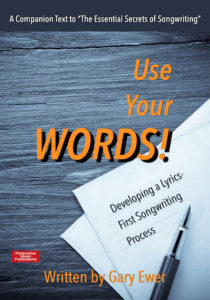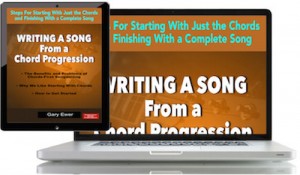 Trying to get lyrics to be more important to your songs? You need to read “Use Your Words! Developing a Lyrics-First Songwriting Process.” Right now, it’s FREE with your purchase of the 10-eBook Bundle.
Trying to get lyrics to be more important to your songs? You need to read “Use Your Words! Developing a Lyrics-First Songwriting Process.” Right now, it’s FREE with your purchase of the 10-eBook Bundle.
Yes, the shape of a melody really can help or hinder what you’re singing about. To be sure, the way that melody and lyric work together is somewhat subjective, so you’re not going to get a set of rules for what to do with a tune to enhance the meaning of your words.
But having said that, one can take a broad look at the way lyrics and melodies from some of the world’s biggest hits over the past several decades, and find certain (albeit vague) commonalities:
- Melodies that hover around one note, or are constructed of repeating melodic ideas within a small range: These are good melodies for lyrics that describe issues of social justice, or any other lyric that gives a strong opinion of something. An example: The verse of “Ohio” (Neil Young). Also, the opening of Bob Dylan’s “Like a Rolling Stone.”
- Melodies that move around mainly by step, exploring the upper and lower reaches of the singer’s range: These melodies are great for lyrics that mainly tell a story, or lay situations out in a kind of “this is what’s happening” sort of way. Example: “Someone Like You” (Adele Adkins, Dan Wilson).
- Melodies that feature strategically-placed leaps, particularly upward ones. Upward-moving melodic leaps have a way of tugging at the heartstrings, and so these kinds of melodies can be great for love songs, or songs with very tender lyrics. And particularly true when those leaps are paired up with emotionally-charged words or phrases. Examples: The opening of the verse for “You Make Me Feel Brand New” (Thom Bell, Linda Creed, recorded by The Stylistics.) Also, “Good Night” (Lennon & McCartney).
And of course, most melodies do a good job of combining all of these characteristics. That’s because most songs will combine many ideas and approaches into one hopefully engaging lyric. A love song will often tell a story, and can also from time to time offer a strong opinion.
All of this is simply a way of reminding you: how your melody and your lyric partner up can make or break your ability to communicate with your audience.
When you take a lyric and simply recite it like poetry, you have a chance to use vocal inflection to enhance the meaning of what you’re saying. Once you’ve added a melody, however, that melody becomes the inflection.
And so it’s up to your melody to enhance the meaning of your lyric.
Try this with a song you’ve recently completed: Read your lyric aloud like poetry, with the same up-and-down shape that your melody traces. Your lyric should come to life as a kind of recited poem that way, and it will tell you if your melody has a chance of properly enhancing the meaning of your words.
 Written by Gary Ewer. Follow Gary on Twitter.
Written by Gary Ewer. Follow Gary on Twitter.
 “The Essential Secrets of Songwriting” eBook bundle includes“Writing a Song From a Chord Progression”. Discover the secrets of making the chords-first songwriting process work for you.
“The Essential Secrets of Songwriting” eBook bundle includes“Writing a Song From a Chord Progression”. Discover the secrets of making the chords-first songwriting process work for you.










